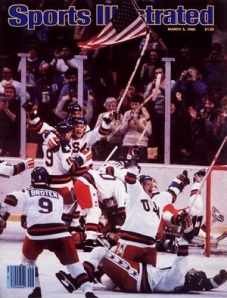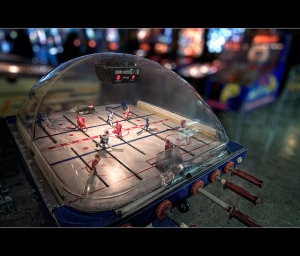Do you believe in miracles?
U.S.A! U.S.A! U.S.A.!
How many times have your heard this chant roused by a conglomerate of beer-in-hand compatriots settled into your local watering hole, awaiting imminent, televised crowning of red, white and blue champions of some fill-in-the-blank international tournament? Probably more so lately if you’re a woman, as American female national teams continue to expand their global dominance outside of basketball – although we’re still pretty good at that, too.
Regardless, that truest of blue sports cries, if you’re wondering, is the offspring of the Top Sports Moment of the 20th Century (as declared by Sports Illustrated in 1999, in case my authority is insufficient). And what better time to bring up this monumental topic? It’s February. The NHL lockout is over. Play has resumed. And for those embittered sports (and culture) fans who have forgotten, or have never been inclined to engage hockey (lockouts are as common in hockey as steroids in… well, pretty much everything else, and the perennial player/owner rivalries have dropped hockey to the bottom of the “big four”), this month marks the 33rd anniversary and perfect time to fall in love with the “Miracle on Ice.”
Great sports moments are all about peculiarities coming together. Curt Schilling pitching through a bloody ankle to lead Boston’s stunning comeback in the 2004 ALCS. Muhammad Ali’s “rope-a-dope” win over George Foreman at the Rumble in the Jungle. It only takes one unpredictable yet serendipitous step for the underdog to secure an immortal victory. But for the 1980 U.S.A. Olympic hockey team, all the pieces could not have been better placed.
For those unfamiliar with the Miracle on Ice, here’s what you need to know: there’s is absolutely no way the United States of America should have beaten the Soviet national hockey team. No way. In truth, the United States should barely have beaten anybody in the 1980 Winter Olympic Games. Back then, the Olympics were for amateur competitors. Professionals weren’t supposed to compete. That said, communist countries technically did not have “professional” players. What they did have, at least in the case of the Soviet Union, were state-of-the-art training programs and facilities, highly sophisticated national leagues, and several players of active military duty… whose only job in the Red Army was to play hockey. Coming into the Lake Placid games, the Soviets had an undefeated record and gold medals from the last four Olympics. As noted by sports commentator, Jim Lampley, hockey was to the Soviet Union then what Basketball is to the United States now. It was their sport.
In comparison, the United States National Hockey Team was a bunch of kids. Team U.S.A. Coach, Herb Brooks, put together a rag-tag team of mostly collegiate players from the University of Minnesota, Boston University, and a few outlying amateur leagues. They lacked the speed, discipline, and cohesiveness that Soviet head coach Viktor Tikhonov had had years to develop – if not mercilessly pummel – into his team. So underwhelming were the Americans, the Soviet team took them of virtually no consequence.
Leading up to the Lake Placid games, the U.S.S.R. displayed their dominance for all the world to see. In late 1979, The Soviets beat the NHL All-Star team in the three-game Challenger Cup series. They later crushed Team U.S.A. 10-3 in an exhibition game at Madison Square Garden on February 9, just two weeks before the Olympics. A demoralizing loss, it echoed the tone of a nation and its frustration at the height of the Cold War.
Threats of a U.S. boycott of the impending Moscow summer games had already been levied in response to the Soviet Union’s 1979 invasion of Afghanistan, increasing tension between the two superpowers. Additional disillusionment in the wake of the Iran hostage crisis put American spirits at an all time low. A beacon of hope was in desperate need, but given the Soviet’s might, it seemed no where to be found.
Enter Herb Brooks, a national team hockey player whose career prior to the 1980 Olympics would best be described at respectable, if not blase. Brooks set a record by playing on eight US National and Olympic teams between 1960 and 1970, but he missed his opportunity at glory after being cut from the 1960 U.S. gold medal Olympic hockey team. He later went on to lead his alma mater, the University of Minnesota, to three NCAA championships as head coach. Looking for something beyond just good, Brooks saw hope in the 1980 Olympic team he was tasked to assemble, and he cultivated that hope with brutal, tactical training. From the moment they were put on ice, Brook’s players received no quarter. In order to match the cohesion of the Soviets, Brooks taunted and bullied his players, driving them to solidarity through a mutual enmity. Immediately after the embarrassing loss to the Soviet club in their exhibition game, Brooks threw his team back on the ice, forcing them to do drills even as the lights were shut off inside MSG.
But if Brooks’ ambition to etch a name for himself in the annals of hockey was harsh, it was not without its benefits. Team U.S.A. entered the first round of Olympic play with a 2-2 tie against Sweden, followed by an upset win over Czechoslovakia – the only team considered a viable rival to the Soviets. Wins over Norway, Romania and finally West Germany put the U.S. team into the medal round against the U.S.S.R. Little did anyone know, the outcome of this game was already being set into motion.
Dismissing Team U.S.A. entirely, Tikhonov chose to rest his players prior to the medal round, while Brooks increased pressure, attempting not to lose the momentum of victory the U.S. had built. As a result, a much more physical and strategic Team U.S.A. skated onto the ice on Friday, February 22. Although they dropped early to 1-0 by a goal off LW Vladimir Krutov at 9:12, U.S.A. answered less than five minutes later with a goal by Buzz Schneider. Sergei Makarov struck back with a goal at 17:34, putting the Soviet’s up 2-1. As the final seconds of the first period wore down, the Soviet’s made a second crucial mistake: waiting for the buzzer to sound and leave them with a one-goal lead going into the second period, the Soviet defensemen neglected a deflected shot by Dave Christian that bounced off goalie Valdislav Tretiak and was rebounded by Mark Johnson, who shot right between the two defenders to score with a second left in the period. The game was now tied 2-2.
Following one gaffe with another, Tikhonov executed arguably the worst decision possible. Perhaps it was spite, perhaps anger; the world may never know. Tretiak, at the time, was widely considered the greatest goaltender in the world, but evidently for Tikhonov, two goals was two too many, and so he replaced Tretiak with second-stringer Vladimir Myshkin. Myshkin shutout the Americans for the second period, and although they outshot the U.S. 12-2, the Soviets were held to one goal in the second period.
With the Soviets up 3-2 in the third period, Mark Johnson scored his second goal of the game on a power play at 48:39. One minute and 21 seconds later, team captain Mike Eruzione fired from the high slot off a pass from Mark Pavelich that went past Myshkin and gave the United State a 4-3 lead. It was their first lead of the game, and a definitive turning point in the history of sports. All Team U.S.A. had to do now was hold the Soviets down for ten minutes.
In a game where players can travel in excess of 20 mph, firing pucks at over 100 mph, ten minutes provides a lifetime’s worth of scoring opportunities. But instead of retracting into a defensive mode, Brooks kept his players on the offensive. The pressure wore on the Soviets, who filled the remaining time with uneven, uncharacteristically sloppy play. Having never used a sixth attacker, Tikhonov kept his goalie in the game during the final minute of play, eliminating any chance of a comeback. As the last seconds on the clock ticked away, sportscaster Al Michaels – along with the attending crowd and presumably anyone able to catch the game on local T.V. (it was pre-recorded for a later national broadcast) – counted down the final seconds and delivered his famous call, “11 seconds, you’ve got 10 seconds, the countdown going on right now! Morrow, up to Silk. Five seconds left in the game. Do you believe in miracles?! YES!”
Team U.S.A. met each other in embrace on the ice. Herb Brooks returned to the locker room to sob. The mighty Soviets had fallen. And America had a new team of heroes to believe in.
The gold, however, wasn’t secure. Bear in mind, this was a round-robin tournament, and thanks to their earlier draw to Sweden, U.S.A. still had to beat Finland to take the gold – which they did with a 4-2 victory, two days after their impossible win over Team U.S.S.R.
Weeks after their win against the Soviets, Team U.S.A. was highlighted on a cover of Sports Illustrated that featured only the jubilation of their inconceivable triumph, and not a word of explanation. None was needed; the Miracle on Ice was a triumph for every American, and every sports fan searching for that ultimate home team win. The Miracle on Ice demonstrated for a country, if not the world, the value of determination and what it means to never succumb to doubt. If you can find a better sports story, in any decade, I’m all ears.
And besides, it gave us this two years later.
Bubble hockey: if that’s not worthy of the Greatest Sports Moment of the 20th Century, I don’t know what is.

